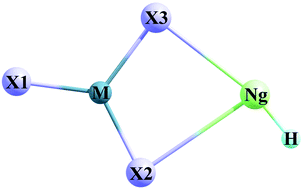Exploring the structure, bonding and stability of noble gas compounds promoted by superhalogens. A case study on HNgMX3 (Ng = Ar–Rn, M = Be–Ca, X = F–Br) via combined high-level ab initio and DFT calculations†
Abstract
A series of complexes (HNgMX3), formed from superhalogen MX3 (M = Be–Ca, X = F–Br) noble gas (Ar–Rn) and the hydrogen atom, were investigated via combined high-level ab initio and DFT calculations. The high vertical electron detachment energy (VDE) of the superhalogen part will lead to charge transfer from the noble gas hydride to it. This charge transfer gives rise to attractive ionic interaction between the two components and to the existence of these complexes as local minima on the potential energy surface eventually. However, the VDE value of the superhalogen part is not always monotonically correlated with the thermodynamic/kinetic stability of the whole complexes. Therefore the superhalogen itself might not be enough to provide information for the correct prediction of the properties of the whole composites. Although there are exothermic channels of dissociation, the existence of energy barrier might ensure the existence of these Ng hydrides under certain conditions. Our analysis indicates the existence of two important factors, functioning in opposite directions, for the energy barriers along the exothermic channel. To achieve a high energy barrier, the attractive interaction between superhalogen and the H atom in the TS, which lowers the barrier, needs to be suppressed effectively. An understanding of the superhalogen-based composites will provide valuable information on the functional properties and potential application of superhalogens. The details of the interaction between different parts of these composites should be one of the areas of focus in these studies.



 Please wait while we load your content...
Please wait while we load your content...